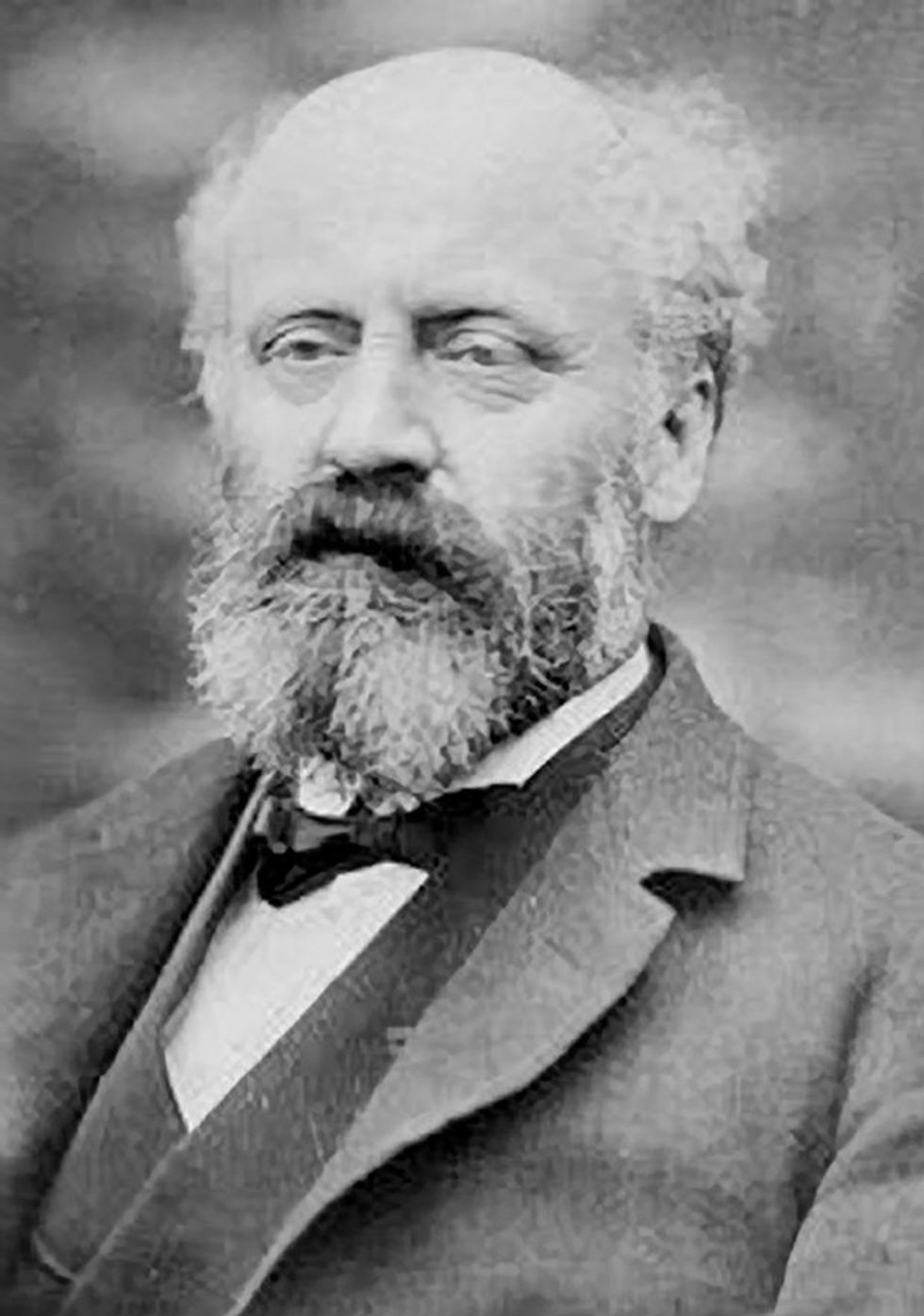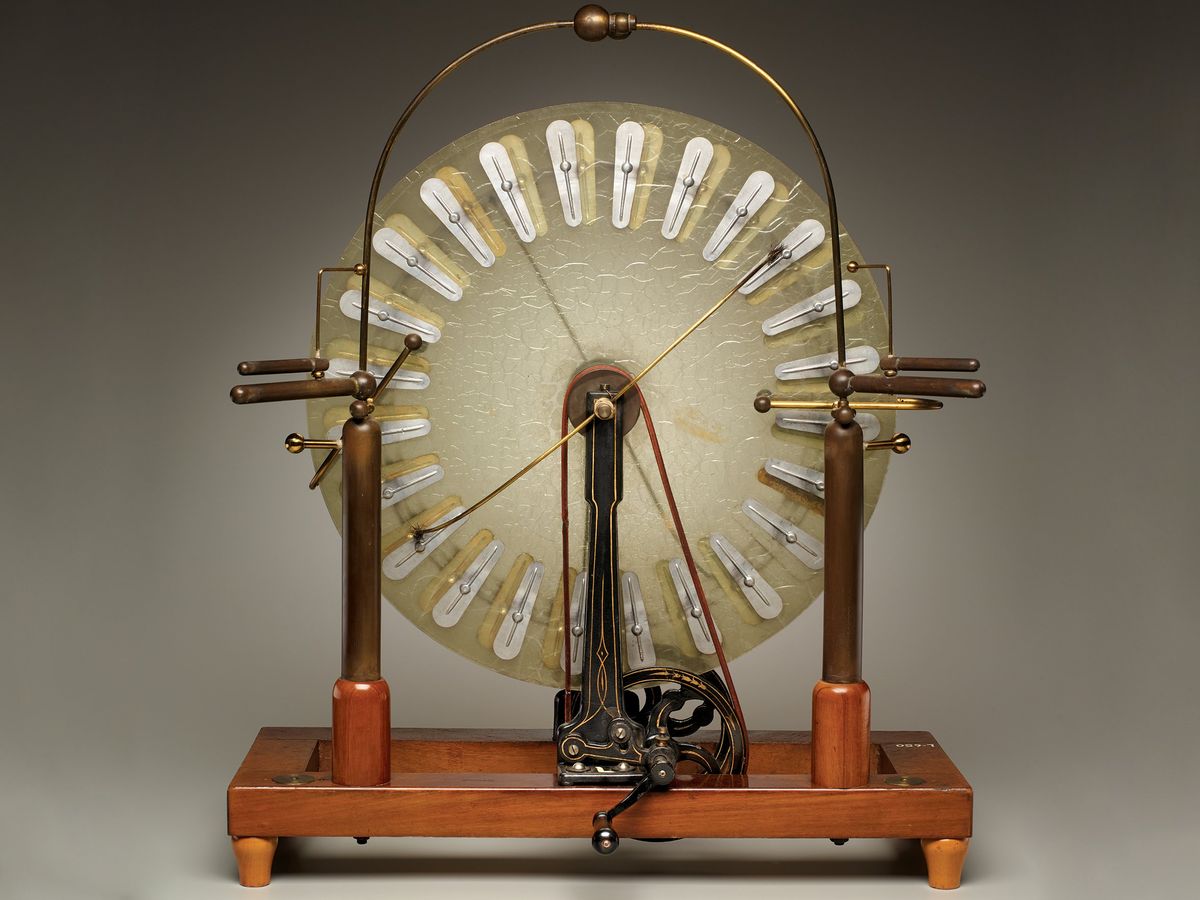The British engineer James Wimshurst did not invent the machine that bears his name. But thanks to his many refinements to a distinctive type of electrostatic generator, we now have the Wimshurst influence machine.
What does a Wimshurst machine do?
Influence machines date back to the 18th century. They are a class of generator that converts mechanical work into electrostatic energy through induction. By the mid-19th century, the German physicists Wilhelm Holtz and August Toepler had each developed a model that featured rotating vertical glass disks. It was this style of generator that Wimshurst began tinkering with in his home workshop in the early 1880s. By 1883 he had solidified his design.
The Wimshurst machine as it exists today has two insulated disks, often made from plastic but sometimes still made from glass, with metal conducting plates positioned around the rims. The disks are mounted on a single axle and rotate in opposite directions when driven by a hand crank.
As the disks rotate, a small starting charge, either positive or negative, on one metal plate will move toward a double-ended brush on the second disk. When the plate aligns with the brush, it will induce an equal and opposite charge on the plate that’s directly across from it on the other disk. The resulting charge in turn causes an opposite charge on a plate on the first disk. Meanwhile, plates on the second disk induce charges on the first disk. Metal collector combs separate the charges into positive and negative and conduct them to two Leyden jar capacitors. The buildup eventually discharges with a spark that jumps the gap between two terminals, and the process begins again. A tabletop Wimshurst machine could produce up to 50,000 or 60,000 volts, as this video demonstrates:
Animate It - Wimshurst Machinewww.youtube.com
The simple design was easy to reproduce and operate, and so Wimshurst machines found their way into laboratories, schools, and even the homes of well-to-do Victorians. Because of the high voltage they could produce, the machines were used to excite Crookes tubes and generate X-rays for medical imaging during the early 20th century.
When Wimshurst died suddenly at his home on 3 January 1903 at the age of 71, the editors at Nature found him worthy of an obituary. Twenty-nine years later, on the centenary of his birth, Nature again published a note calling him “among the best-known inventors of electrical machines of the last part of the nineteenth century.” And yet, to my knowledge, there’s no dedicated, full-length biography of the man. In fact, most online searches turn up the same set of details noted in Nature’s original reports: He was the son of shipbuilder Henry Wimshurst (the pioneering constructor of the screw-propelled ship Archimedes); apprentice at the Thames Iron Works; ship surveyor to Lloyd’s Register; from 1865 to 1874, chief of the Liverpool Underwriters’ Registry; and finally for the last 25 years of his working life, until reaching the mandatory retirement age of 67, principal shipwright surveyor for the Board of Trade.

Wimshurst’s electrical pursuits were entirely a hobby, something he did in his spare time at his house in Clapham in southwest London. With the assistance of his two sons, he created a laboratory and workshop where he tinkered with influence machines until he perfected his design. Wimshurst made more than 90 of his eponymous machines. Most fit easily on a tabletop, such as this one preserved at the Science Museum London, which measures 56 by 67 by 30.5 centimeters. But he also created one exceptionally large machine that’s 2.1 meters tall and on exhibit at the Museum of Science and Industry in Chicago. (The machine pictured at top is at the Yale Peabody Museum of Natural History, in New Haven, Conn. It was manufactured in Germany and sold in the United States by James W. Queen & Co.)
Wimshurst never patented any of his refinements to the machine, but he was eager to get the word out about his inventions. In 1886 he published a book, Static Electricity. The “Influence Machine”: How to Make It and How to Use It. And on 27 April 1888, he delivered a lecture on the machines at the Royal Institution. Recognized for his scientific achievements, in 1898 he was elected a fellow of the Royal Society. He was also a member of the Institution of Electrical Engineers and the Rӧntgen Society, and a member of the board of managers of the Royal Institution.
But the part of Wimshurst’s history I find most interesting is in the last paragraph of Nature’s obituary: “All Mr. Wimshurst’s scientific research was done for pure love of the work, and he persistently refused to accept any pecuniary benefit from it.” Perhaps that’s why historians haven’t yet written his biography: They don’t know how to treat a truly altruistic inventor.
Try this at home: an electric kiss
Wimshurst machines are readily available for purchase today. They’re still used in schools and science museums to demonstrate the basics of electricity. You can also build your own device with items from a hardware store.
In volume 17 of Make magazine (2009), the steampunk enthusiast known as Jake von Slatt described how to build a Wimshurst machine. (Von Slatt also appeared in IEEE Spectrum’s October 2008 article “The Steampunk Contraptors.”) His updated instructions are available online in a five-part series.
If you do decide to go all in on making your own Wimshurst machine, I suggest taking it to the logical next step of planning a dinner party around Victorian parlor tricks. Rather than breaking out Monopoly, Trivial Pursuit, or Parcheesi yet again, why not party like the Victorians, who were apparently mad about electricity.
To be clear, the Victorians were simply continuing a trend that dated back more than a century; Ben Franklin also liked to entertain his guests with electricity-based games. Thanks to the simplicity of the Wimshurst machine, partygoers in the 1890s had a reliable source of easily generated electricity.
One popular game was called the electrical kiss: Crank up your Wimshurst machine, get a courting couple to each take hold of one of the capacitors, and have them lean in for a surprise. It’s a little more shocking than spin the bottle. Although none of the literature I reviewed showed concern about the kissing couple accidentally electrocuting themselves, the website of Indiana University’s department of physics carries a warning about demonstrating its Wimshurst machine: “Can produce lethal shocks when connected to too many Leyden jars.”
Part of a continuing series looking at historical artifacts that embrace the boundless potential of technology.
An abridged version of this article appears in the June 2023 print issue as “Wimshurst’s Electrostatic Immortality.”
Allison Marsh is a professor in Women and Gender Studies at the University of South Carolina and codirector of the university’s Ann Johnson Institute for Science, Technology & Society. She combines her interests in engineering, history, and museum objects to write the Past Forward column, which tells the story of technology through historical artifacts. Marsh is currently working on a book on the history of women in electrical engineering.



